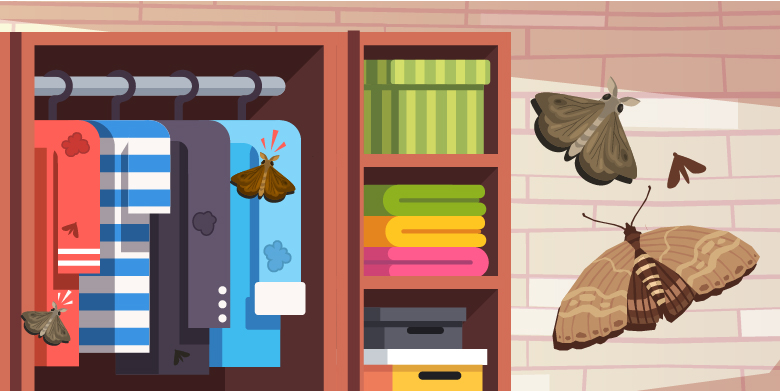Do All Moths Eat Clothing?

As a society, we hold a long-standing grudge against moths for their tendency to chew holes in our favourite clothes. You pack your thick knitted winter jumper away in the spring, but by next Christmas when you pull it back out for that familiar cosy comfort, it’s peppered with not-so-subtle signs of regular feasts.
But are we too harsh on the moths? In this article, we’re looking at the moths that do and the moths that don’t enjoy a nibble on your wardrobe.
Do moths eat clothes?
You might take it as a given fact that moths are the ones eating at your clothes. But did you know that, as grown adults, moths rarely eat anything? Some species – such as the Luna moth – don’t even have mouths. So how can they be eating the clothes in your drawers? The truth is that the moth’s larvae are the real culprits.
Before they grow into adults, moth larvae will need to feed – and they have quite a specific diet. They’re on the lookout for materials which contain keratin. Wool, silk, fur and cashmere are common targets, but they’ll avoid synthetic fibres such as polyester, spandex and nylon – due to their lack of keratin.
Do all moth larvae eat clothes?
There are many species of moths living in the UK – over 2500 have been recorded – but not every single one will spawn larvae that have a natural taste for tshirts. In fact, there are only a small selection of species (collectively known as ‘clothes moths’) which hunt out animal fibres in your clothing.
The most common species of moth we can hold accountable for this behaviour is Tineola bisselliella, more simply known as ‘the webbing clothes moth’ or the ‘common clothes moth’.
So do moths live in my clothes?
An adult moth can lay up to 1,000 eggs – but why do they choose to spawn their young right in the middle of your wardrobe? Moths like to breed in dark, warm conditions. Understandably, they also want to lay their eggs in places where they won’t be disturbed. Ideally, too, they will want to provide a nearby food source for the larvae once the eggs hatch; add all of this together and your wardrobe or drawers rise to the top of the list.
Attracted to moisture
Moth larvae are particularly attracted to moist clothes – that includes dirty or sweaty clothes you might have neglected to wash. This might mean that adult moths will lay eggs on moist clothes which do not contain keratin in order to get them close to ones that do.
With this attraction to moisture, an effective deterrent to moth infestations is dry cleaning your clothes – although this obviously isn’t realistic for everyone.
How do I solve a moth infestation?
Moth larvae are notoriously difficult to spot; often, the first time you’ll notice their presence is when you see the aftermath of their feeding habits. Because of this, it’s most important to prevent an infestation from occuring in the first place.
There are some simple steps you can take to minimise the chances of an infestations gripping your home – and your clothes. These include:
- Vacuum often – In addition to clothes, moths can also nest in your carpets, so vacuum them regularly to remove any eggs that might be hiding in plain sight.
- Dry and clean clothes – Damp or stained clothes are highly attractive to moths, so make sure that any clothes you’re storing away are thoroughly cleaned beforehand.
- Seal textiles and clothes in bags – Particularly for seasonal clothes you won’t touch for months on end, you can use sealed bags to store them safely. Winter clothes, for instance, will fare in vacuum-sealed bags than they would just neatly folded and put away in the back of a chest of drawers.
If the infestation is getting out of control – or your preventative measures don’t seem to be working – the best way to eliminate the issue is to call in the professionals. Not only will trained pest control technicians be able to resolve an existing infestation, they will also provide tailored advice and assistance to prevent future issues.
At ClearFirst Pest Control, we provide a dedicated moth control service to homes across Derby and the surrounding areas. From reactive moth removal to proactive maintenance to prevent infestations from recurring, our friendly team is on hand to help, keeping your home pest free and your clothes safe from harm.



